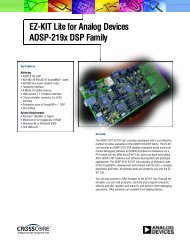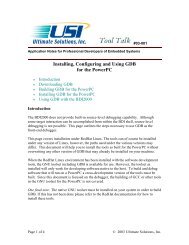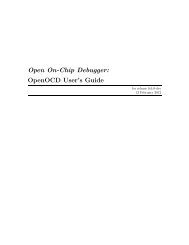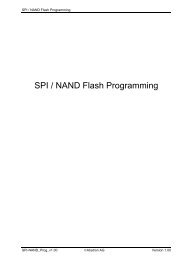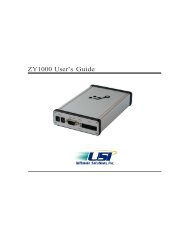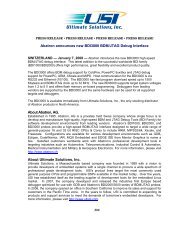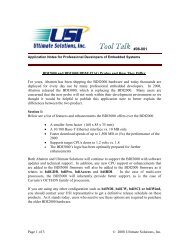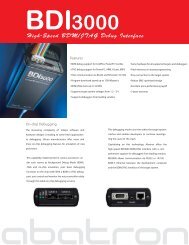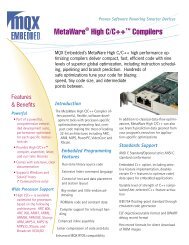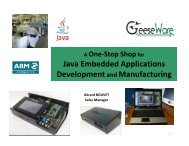STM32 Journal - Digikey
STM32 Journal - Digikey
STM32 Journal - Digikey
Create successful ePaper yourself
Turn your PDF publications into a flip-book with our unique Google optimized e-Paper software.
<strong>STM32</strong> <strong>Journal</strong><br />
The <strong>STM32</strong> L1’s high level of<br />
integration enables it to provide<br />
a single-chip solution, with<br />
the exception of a few analog<br />
signal conditioning circuits,<br />
for many portable medical<br />
applications, including glucose<br />
meters, heart-rate monitors,<br />
and pulse oximeters. For<br />
example, in a glucose meter<br />
(see Figure 4), the <strong>STM32</strong><br />
L1 can automatically wake<br />
from sleep when a test strip<br />
is inserted into the device. Its<br />
2-channel DAC can be used to<br />
generate a strip bias, enable<br />
strip calibration, and output<br />
audible instructions and test<br />
results. Timers accurately<br />
control the ADC trigger for<br />
sample measurement, onboard<br />
comparators measure correct<br />
sample staging, and the<br />
temperature sensor logs the<br />
ambient temperature for use in<br />
calculating results. Developers<br />
can also use the integrated<br />
comparators to create a powerefficient<br />
analog watchdog that<br />
monitors an input and wakes<br />
the <strong>STM32</strong> L1 when either the<br />
upper or lower threshold is<br />
exceeded (see Figure 5).<br />
A key manner in which the<br />
<strong>STM32</strong> architecture conserves<br />
power is through the ability of<br />
the CPU to sleep during ADC<br />
Glucose<br />
Test Strip<br />
Vout<br />
Cal<br />
Reference<br />
Temp<br />
Sensor<br />
Strip Detect<br />
<strong>STM32</strong> L1<br />
DMA Controllers<br />
Timers<br />
PWM<br />
1 x 12-bit ADC<br />
26 channels/<br />
1Msps<br />
2 x Comparators<br />
2 x 12-bit DAC<br />
sample capture. To achieve this,<br />
the entire analog data capture<br />
chain needs to be completely<br />
automated, with no need for<br />
CPU intervention at any point<br />
after the chain is initiated.<br />
Specifically, after the CPU<br />
configures and starts the auto<br />
Data EEPROM 4KB<br />
Up to 16KB SRAM<br />
64KB-128KB<br />
Flash Memory<br />
CORTEX TM -M3<br />
CPU 32 MHz<br />
With MPU<br />
8x40<br />
Segment LCD<br />
2 x I 2 C<br />
GPIOs<br />
sample capture, it enters sleep<br />
mode. Between samples, the<br />
ADC enters an automatic shut<br />
down mode until a timer triggers<br />
it. The ADC captures the current<br />
sample, using the DMA to store<br />
the data in SRAM, and then<br />
shuts down again. This process<br />
Power Supply<br />
Reg 1.8V/1.5V/1.2V<br />
POR/PDR/PVD/BOR<br />
RTC/AWU +<br />
80B Backup Regs<br />
USB 2.0 FS<br />
Figure 4 The <strong>STM32</strong> L1’s high level of integration enables it to provide a single-chip solution, with the exception of a few<br />
analog signal conditioning circuits, for many portable medical applications such as blood glucose meters.<br />
2 AA battery<br />
Internet<br />
Host PC<br />
LCD Panel<br />
8 x 40<br />
USER Buttons<br />
Voice<br />
repeats until the entire capture<br />
sequence is complete. The<br />
DMA will then wake the CPU to<br />
process the samples that have<br />
been stored in SRAM.<br />
The power savings can be<br />
significant using the unique<br />
ability of the <strong>STM32</strong> L1 to<br />
30




